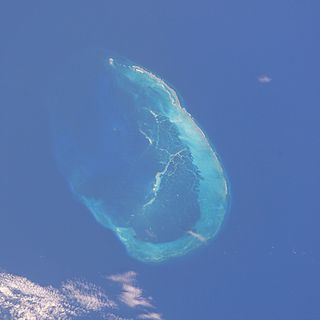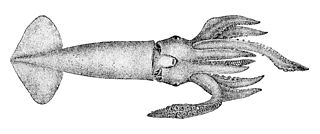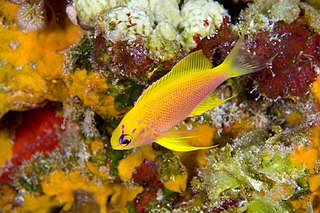
The Hawaiian crow or ʻalalā is a species of bird in the crow family, Corvidae, that is currently extinct in the wild, though reintroduction programs are underway. It is about the size of the carrion crow at 48–50 cm (19–20 in) in length, but with more rounded wings and a much thicker bill. It has soft, brownish-black plumage and long, bristly throat feathers; the feet, legs and bill are black. Today, the Hawaiian crow is considered the most endangered of the family Corvidae. They are recorded to have lived up to 18 years in the wild, and 28 years in captivity. Some Native Hawaiians consider the Hawaiian crow an ʻaumakua.

Ommastrephidae is a family of squid containing three subfamilies, 11 genera, and over 20 species. They are widely distributed globally and are extensively fished for food. One species, Todarodes pacificus, comprises around half of the world's cephalopod catch annually.

The French Frigate Shoals is the largest atoll in the Northwestern Hawaiian Islands. Its name commemorates French explorer Jean-François de La Pérouse, who nearly lost two frigates when attempting to navigate the shoals. It consists of a 20-mile (32 km) long crescent-shaped reef, twelve sandbars, and the 120-foot (37 m) high La Perouse Pinnacle, the only remnant of its volcanic origins. The total land area of the islets is 61.508 acres (24.891 ha). Total coral reef area of the shoals is over 232,000 acres (94,000 ha). Tern Island, with an area of 26.014 acres (10.527 ha), has a landing strip and permanent habitations for a small number of people. It is maintained as a field station in the Hawaiian Islands National Wildlife Refuge by the United States Fish and Wildlife Service. The French Frigate Shoals are about 487 nautical miles northwest of Honolulu.

The red-tailed tropicbird is a seabird native to tropical parts of the Indian and Pacific Oceans. One of three closely related species of tropicbird (Phaethontidae), it was described by Pieter Boddaert in 1783. Superficially resembling a tern in appearance, it has almost all-white plumage with a black mask and a red bill. The sexes have similar plumage. As referenced in the common name, adults have red tail streamers that are about twice their body length. Four subspecies are recognised, but there is evidence of clinal variation in body size—with smaller birds in the north and larger in the south—and hence no grounds for subspecies.

Euprymna scolopes, also known as the Hawaiian bobtail squid, is a species of bobtail squid in the family Sepiolidae native to the central Pacific Ocean, where it occurs in shallow coastal waters off the Hawaiian Islands and Midway Island. The type specimen was collected off the Hawaiian Islands and is deposited at the National Museum of Natural History in Washington, D.C..

Euprymna is a genus of bobtail squid comprising a number of species.

Heteroteuthis hawaiiensis is a species of bobtail squid native to the central and western Pacific Ocean. It occurs in waters off Hawaii, Bonin, the Ryukyu Islands, Indonesia, and the Great Australian Bight. H. hawaiiensis may also be present in Banc Combe in the southwestern Pacific at depths of 795 to 820 m.

Iridoteuthis iris is a species of bobtail squid native to the northern central Pacific Ocean; it occurs near the Hawaiian Islands off the southeast and northwest Hancock, Colahan, and Kammu seamounts. There exists a doubtful record from the Ceram Sea. Unlike most other bobtail squid, I. iris is pelagic and lives in the open ocean.
The anchialine pool snail, scientific name Neritilia hawaiiensis, is a species living in brackish estuaries and in anchialine pools. These snails have an operculum, and are aquatic gastropod mollusk in the family Neritiliidae.
Nothocestrum longifolium, the longleaf ʻaiea, is a species of tree in the nightshade family, Solanaceae, that is endemic to Hawaiʻi. It can be found in mesic and wet forests at elevations of 360–1,620 metres (1,180–5,310 ft) on the islands of Maui, Molokaʻi, Lānaʻi, Oʻahu, Kauaʻi. It is threatened by habitat loss.
Dracaena konaensis, synonym Pleomele hawaiiensis, the Hawaiʻi hala pepe, is a rare species of flowering plant that is endemic to the island of Hawaiʻi in the state of Hawaii.

The Japanese flying squid, Japanese common squid or Pacific flying squid, scientific name Todarodes pacificus, is a squid of the family Ommastrephidae. This animal lives in the northern Pacific Ocean, in the area surrounding Japan, along the entire coast of China up to Russia, then spreading across the Bering Strait east towards the southern coast of Alaska and Canada. They tend to cluster around the central region of Vietnam.

Pterygioteuthis microlampas is a species of squid in the family Pyroteuthidae. They occur from northern New Zealand oceans to the Hawaiian Islands, but they do not overlap with the species P. gemmata, which lives in more southern waters. While there are numerous similarities between these two species, they are separated by the smaller mature size of P. microlampas and the fewer number of hooks on males. The species reproduce sexually during the late autumn to early winter, producing eggs with a diameter of 0.9 mm.

Nototodarus sloanii is a species of squid commonly known as the New Zealand arrow squid or Wellington flying squid. It is also known by its Māori name of Wheketere. It is a favoured prey species of a number of marine mammals and diving birds. It is an important food source for the New Zealand fur seal and the endangered species: New Zealand sea lion and yellow-eyed penguin. N. sloanii is sought by trawler fishermen for human consumption; in this trawling process, Australian sea lions are frequently killed, since they prey upon N. sloanii.

Nototodarus is a genus of squid. Example species in this genus include Nototodarus sloanii, a species sought for human food; in the process of harvesting N. sloanii Australian sea lions are frequently killed, since that marine mammal preys upon this squid species. Furthermore, New Zealand arrow squid, N. sloanii, is an important food source for the endangered yellow-eyed penguin, Megadyptes antipodes.

Stenogobius hawaiiensis, the Naniha goby, is a species of goby endemic to the Hawaiian Islands where it can be found in marine, brackish and fresh waters. This species is not as adept a climber as are many other Hawaiian gobies and thus is not found in the upper reaches of streams. This species can reach a length of 11.4 centimetres (4.5 in) SL. In the Hawaiian language, it is also known as O'opu naniha. It feeds on invertebrates such as worms, crustaceans and insects as well as algae. It is preyed upon by birds such as the black-crowned night-heron as well as native fishes such as Caranx spp., Polydactylus sexfilis and Sphyraena barracuda. Invasive alien fish such as mosquito fish and game species threaten the populations of S. hawaiiensis by bringing new diseases and parasites and by predating on their eggs and fry. They may also be threatened by alteration of their habitat by humans such as abstraction, pollution and damming but not to as great an extent as these factors affect other native Hawaiian freshwater fish, there is also some fishing for this species.

Todarodinae is a squid subfamily in the family Ommastrephidae.

Pseudanthias hawaiiensis, the Hawaiian longfin anthias, is a small colorful species of fish in the subfamily Anthiinae. It is often treated as a subspecies of P. ventralis, but some authorities prefer to treat them as separate species. It is endemic to reefs at depths of 26–219 m (85–719 ft) in Hawaii and the Johnston Atoll.
Eucleoteuthis is a monotypic genus of squid from the family Ommastrephidae, the only species is Eucleoteuthis luminosa, the striped flying squid or luminous flying squid.

Nototodarus gouldi, also known as the Gould's squid, Gould's flying squid, or arrow squid, is a squid belonging to the family Ommastrephidae. It inhabits the tropical and temperate waters of Australia and New Zealand. It is frequently caught and eaten for food. They live up to one year.

















